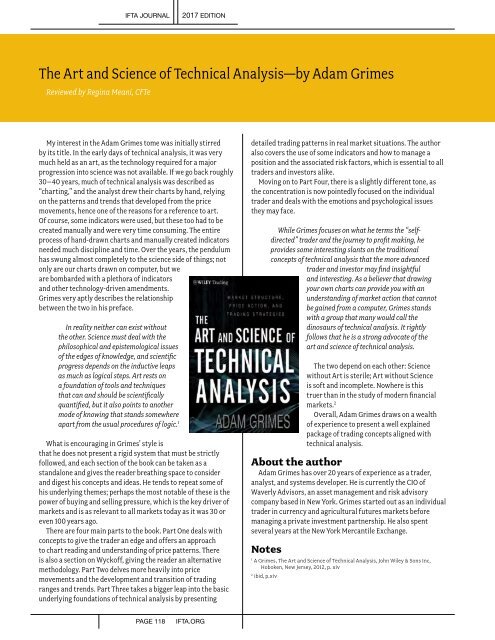You also want an ePaper? Increase the reach of your titles
YUMPU automatically turns print PDFs into web optimized ePapers that Google loves.
IFTA JOURNAL<br />
2017 EDITION<br />
The Art and Science of Technical Analysis—by Adam Grimes<br />
Reviewed by Regina Meani, CFTe<br />
My interest in the Adam Grimes tome was initially stirred<br />
by its title. In the early days of technical analysis, it was very<br />
much held as an art, as the technology required for a major<br />
progression into science was not available. If we go back roughly<br />
30–40 years, much of technical analysis was described as<br />
“charting,” and the analyst drew their charts by hand, relying<br />
on the patterns and trends that developed from the price<br />
movements, hence one of the reasons for a reference to art.<br />
Of course, some indicators were used, but these too had to be<br />
created manually and were very time consuming. The entire<br />
process of hand-drawn charts and manually created indicators<br />
needed much discipline and time. Over the years, the pendulum<br />
has swung almost completely to the science side of things; not<br />
only are our charts drawn on computer, but we<br />
are bombarded with a plethora of indicators<br />
and other technology-driven amendments.<br />
Grimes very aptly describes the relationship<br />
between the two in his preface.<br />
In reality neither can exist without<br />
the other. Science must deal with the<br />
philosophical and epistemological issues<br />
of the edges of knowledge, and scientific<br />
progress depends on the inductive leaps<br />
as much as logical steps. Art rests on<br />
a foundation of tools and techniques<br />
that can and should be scientifically<br />
quantified, but it also points to another<br />
mode of knowing that stands somewhere<br />
apart from the usual procedures of logic. 1<br />
What is encouraging in Grimes’ style is<br />
that he does not present a rigid system that must be strictly<br />
followed, and each section of the book can be taken as a<br />
standalone and gives the reader breathing space to consider<br />
and digest his concepts and ideas. He tends to repeat some of<br />
his underlying themes; perhaps the most notable of these is the<br />
power of buying and selling pressure, which is the key driver of<br />
markets and is as relevant to all markets today as it was 30 or<br />
even 100 years ago.<br />
There are four main parts to the book. Part One deals with<br />
concepts to give the trader an edge and offers an approach<br />
to chart reading and understanding of price patterns. There<br />
is also a section on Wyckoff, giving the reader an alternative<br />
methodology. Part Two delves more heavily into price<br />
movements and the development and transition of trading<br />
ranges and trends. Part Three takes a bigger leap into the basic<br />
underlying foundations of technical analysis by presenting<br />
detailed trading patterns in real market situations. The author<br />
also covers the use of some indicators and how to manage a<br />
position and the associated risk factors, which is essential to all<br />
traders and investors alike.<br />
Moving on to Part Four, there is a slightly different tone, as<br />
the concentration is now pointedly focused on the individual<br />
trader and deals with the emotions and psychological issues<br />
they may face.<br />
While Grimes focuses on what he terms the “selfdirected”<br />
trader and the journey to profit making, he<br />
provides some interesting slants on the traditional<br />
concepts of technical analysis that the more advanced<br />
trader and investor may find insightful<br />
and interesting. As a believer that drawing<br />
your own charts can provide you with an<br />
understanding of market action that cannot<br />
be gained from a computer, Grimes stands<br />
with a group that many would call the<br />
dinosaurs of technical analysis. It rightly<br />
follows that he is a strong advocate of the<br />
art and science of technical analysis.<br />
The two depend on each other: Science<br />
without Art is sterile; Art without Science<br />
is soft and incomplete. Nowhere is this<br />
truer than in the study of modern financial<br />
markets. 2<br />
Overall, Adam Grimes draws on a wealth<br />
of experience to present a well explained<br />
package of trading concepts aligned with<br />
technical analysis.<br />
About the author<br />
Adam Grimes has over 20 years of experience as a trader,<br />
analyst, and systems developer. He is currently the CIO of<br />
Waverly Advisors, an asset management and risk advisory<br />
company based in New York. Grimes started out as an individual<br />
trader in currency and agricultural futures markets before<br />
managing a private investment partnership. He also spent<br />
several years at the New York Mercantile Exchange.<br />
Notes<br />
1<br />
A Grimes, The Art and Science of Technical Analysis, John Wiley & Sons Inc,<br />
Hoboken, New Jersey, 2012, p. xiv<br />
2<br />
ibid, p.xiv<br />
PAGE 118<br />
IFTA.ORG


